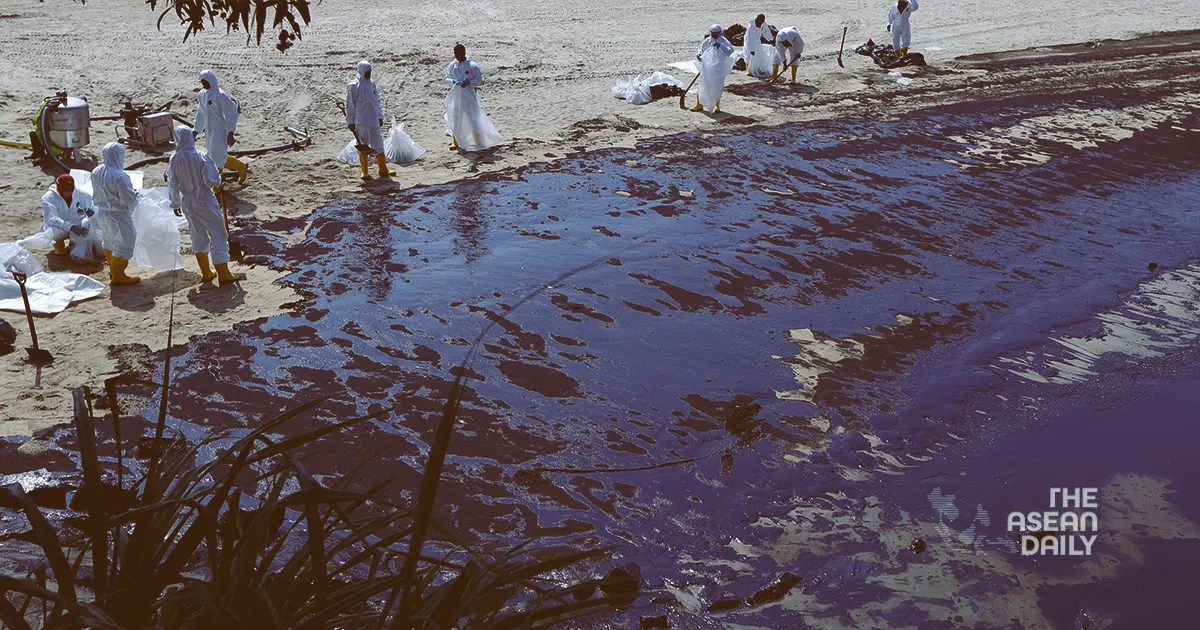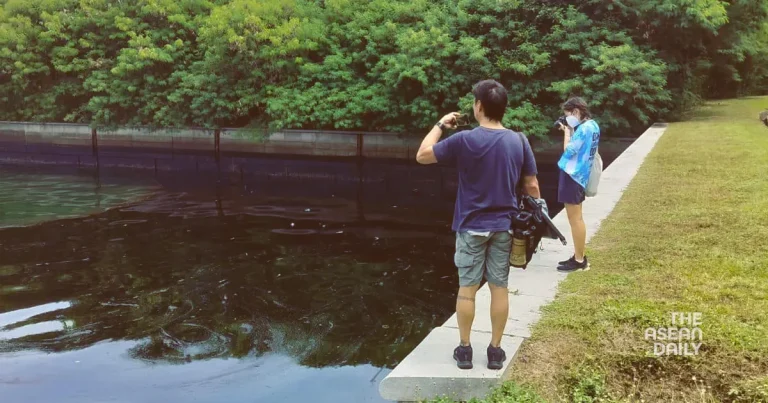18-6-2024 (SINGAPORE) In a race against time, authorities here are intensifying cleanup efforts following a major oil spill on June 14, as the environmental fallout spreads to more areas. On June 17, reports emerged that oil leaking from a damaged cargo tank at Pasir Panjang Terminal had reached the waters off Changi, prompting swift action to contain the expanding slick.
According to a joint statement by the Maritime and Port Authority of Singapore, National Environment Agency (NEA), National Parks Board (NParks), national water agency PUB, Sentosa Development Corporation, and Singapore Food Agency, around 1,500 meters of containment booms have been deployed to restrict the oil’s movement. An additional 1,600 meters of booms are set to be installed at several beaches on Sentosa Island, Labrador Nature Reserve, and the Southern Islands by June 18.
Booms have also been strategically placed along stretches of East Coast Park beaches severely affected by the spill, as well as at canal openings, to trap the oil and prevent it from flowing back into the waterways. As a preventive measure, booms will also be positioned off Changi East.
“Some of the oil has been seen off Changi today,” the joint statement confirmed, adding that oil absorbent booms have been preemptively deployed at biodiversity-sensitive areas such as Chek Jawa Wetlands at Pulau Ubin, Coney Island Park, and Pasir Ris Park.
N. Sivasothi, a senior lecturer at the National University of Singapore, attributed the oil’s eastward movement to the prevailing southwest monsoon season, with winds blowing from the south. “This is still disconcerting. We are certainly hoping that the volume of oil has already been significantly reduced by the cleanup teams who are working hard to remove it,” he said.
Environmental experts have raised concerns about the potential impact on delicate ecosystems. Muhammad Nasry, Executive Director of Singapore Youth Voices for Biodiversity, highlighted the vulnerability of Chek Jawa’s mangrove, mudflat, and seagrass habitats. “Oil slicks can block light from reaching seagrasses, which require sunshine to photosynthesize. Seagrasses are also known to lose chlorophyll – the compound in plants that enables them to convert sunshine to nutrition – when exposed to chemical pollutants,” he explained.
Nasry also warned of the challenges posed by oil contamination in mangrove areas, stating, “If oil is deposited onto a sandy shoreline, the oiled-up sand can be scooped up easily. But in mangrove habitats, if the oil goes in, it’s not going to come out easily.”
In response to the evolving situation, additional containment and absorbent booms will be deployed over the next few days to safeguard fish farms at the East Johor Strait, Chek Jawa Wetlands, and Changi Creek. Moreover, a specialized oil floating containment and recovery device, known as the Current Buster system, will be utilized on June 18 off the Changi Exhibition Centre as a precautionary measure.
While West Coast Park remains unaffected, oil absorbent booms have been deployed at the park to protect the Marsh Garden’s mangroves, according to the statement.
Sivasothi expressed encouragement at the mitigation protocols activated, stating, “The early deployment will certainly help protect sensitive biodiversity areas and fish farms in the eastern Johor Strait.”
The oil spill originated on June 14 when the Netherlands-flagged dredger Vox Maxima collided with the stationary Singapore-flagged bunker vessel, Marine Honour, at Pasir Panjang Terminal. The impact caused a rupture in one of Marine Honour’s oil tanks, leading to the leak. Residents and visitors in affected areas reported a “strong smell of oil” following the incident.
Although the NEA has been conducting daily air quality tests and found levels to be within safe limits so far, the public is advised to avoid swimming or engaging in water activities at Changi Beach until further notice.
To facilitate cleanup efforts, several beaches will remain closed until further notice, including East Coast Park (from Area B to H), Labrador Nature Reserve (Jetty and Rocky Shore), Tanjong, Palawan, and Siloso beaches on Sentosa, as well as beaches at St John’s, Lazarus, and Kusu islands.

NParks acknowledged the overwhelming response from public volunteers but stated that for safety reasons, volunteers would not be deployed for shoreline cleanup operations. In a Facebook post on June 17, Minister for National Development Desmond Lee reminded the public to stay away from beachfronts, emphasizing that the cleanup should be carried out by professionals.




